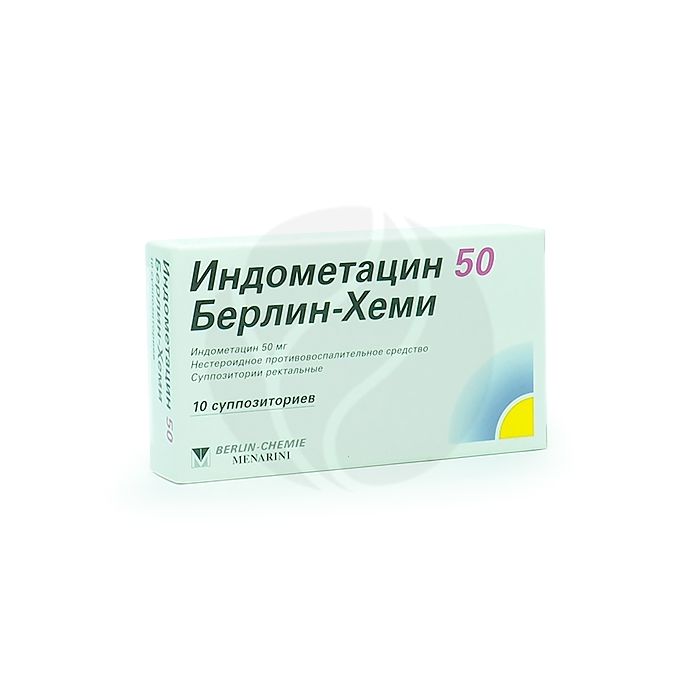Indomethacin Berlin-Chemie suppositories 50mg, No. 10
Expiration Date: 05/2027
Russian Pharmacy name:
Индометацин Берлин-Хеми суппозитории 50мг, №10
Inflammatory and degenerative diseases of the musculoskeletal system:
rheumatoid arthritis, psoriatic, juvenile chronic arthritis, ankylosing spondylitis;
rheumatic lesions of soft tissues;
gouty arthritis.
as part of complex therapy for infectious and inflammatory diseases of the ENT organs, adnexitis, prostatitis, cystitis, neuritis, algodismenorrhea, headache and toothache (as part of combination therapy).
Rectally (injected into the rectum). It is recommended to empty the intestines before using the suppository.
For adults, suppositories 100 mg, 1 suppository 1 time / day; suppositories 50 mg 1 suppository 1-3 times / day.
During a gout attack, up to 200 mg / day.
Rectal suppositories are white with a yellowish tinge, torpedo-shaped with a depression at the base.
1 supp. indomethacin 50 mg
Excipients: solid fat - 800 mg, corn starch - 100 mg.
Peptic ulcer and duodenal ulcer;
ulcerative colitis;
bleeding (intracranial, gastrointestinal);
congenital heart defects (coarctation of the aorta, pulmonary atresia, tetrad of Fallot);
heart failure;
arterial hypertension;
violation of color vision;
optic nerve disease;
cirrhosis of the liver with portal hypertension;
liver failure;
bronchial asthma;
hemophilia, hypocoagulation, other blood diseases;
chronic renal failure;
hearing loss;
pathology of the vestibular apparatus;
deficiency of glucose-6-phosphate dehydrogenase;
proctitis, hemorrhoids;
pregnancy and the period of breastfeeding;
children and adolescents up to 18 years old;
hypersensitivity to indomethacin and other NSAIDs, incl. 'aspirin' asthma.
With care: with hyperbilirubinemia, thrombocytopenia, epilepsy, parkinsonism, depression, as well as in elderly patients.
pharmachologic effect
The drug is from the NSAID group, has anti-inflammatory, analgesic, antipyretic and antiaggregatory effects. Suppresses the activity of pro-inflammatory factors, reduces platelet aggregation. By inhibiting cyclooxygenase 1 and 2, it disrupts the metabolism of arachidonic acid, reduces the amount of prostaglandins (Pg) both in the focus of inflammation and in healthy tissues, and suppresses the exudative and proliferative phases of inflammation. It causes a weakening or disappearance of pain syndrome of a rheumatic and non-rheumatic nature (including pain in the joints at rest and during movement, a decrease in morning stiffness and swelling of the joints, helps to increase the range of motion; in inflammatory processes that occur after operations and injuries, quickly relieves both spontaneous pain and pain on movement, reduces inflammatory edema at the site of the wound).
Pharmacokinetics
Absorption is fast. Bioavailability with the rectal route of administration is 80-90%. Communication with plasma proteins - 90%, T1 / 2 - 4-9 hours. Metabolized, mainly in the liver, 30% of the drug is excreted unchanged. 70% is excreted by the kidneys, 30% through the intestines. Cannot be removed by dialysis. Penetrates into breast milk.
Side effect
From the digestive system: NSAIDs-gastropathy, abdominal pain, nausea, vomiting, heartburn, anorexia, diarrhea, liver dysfunction (increased blood bilirubin, 'hepatic' transaminases). With prolonged use in large doses - ulceration of the mucous membrane of the gastrointestinal tract.
From the nervous system: headache, dizziness, insomnia, agitation, irritability, fatigue, drowsiness, depression, peripheral neuropathy.
From the senses: hearing loss, tinnitus, taste disturbance, diplopia, blurred vision, corneal opacity, conjunctivitis.
From the side of the cardiovascular system: heart failure, tachyarrhythmia, increased blood pressure.
From the urinary system: impaired renal function, proteinuria, hematuria, interstitial nephritis, nephrotic syndrome, papillary necrosis.
From the hemostatic system: bleeding (gastrointestinal, gingival, uterine, hemorrhoidal), thrombocytopenia.
Allergic reactions: skin rash, itching, urticaria, Quincke's edema, bronchospasm; rarely - Lyell's syndrome, erythema nodosum, anaphylactic shock.
From the hematopoietic system: agranulocytosis, leukopenia, aplastic anemia, autoimmune hemolytic anemia.
From the side of metabolism: hyperglycemia, glucosuria.
On the part of the water and electrolyte balance: hyperkalemia.
Others: aseptic meningitis (more often in patients with autoimmune diseases), increased sweating, edema syndrome.
Local reactions: burning, itching, heaviness in the anorectal region, exacerbation of hemorrhoids.
Application during pregnancy and lactation
The drug is contraindicated for use during pregnancy and during breastfeeding.
Application for violations of liver function
The drug is contraindicated for use in patients with liver cirrhosis and portal hypertension, as well as in liver failure.
During treatment, it is necessary to monitor the functional state of the liver.
Application for impaired renal function
The drug is contraindicated for use in chronic renal failure.
During treatment, it is necessary to monitor the functional state of the kidneys.
Application in children
The drug is contraindicated for use in children under the age of 18.
Use in elderly patients
The drug is prescribed with caution to elderly patients.
special instructions
During treatment, it is necessary to control the picture of peripheral blood and the functional state of the liver and kidneys. If it is necessary to determine 17-ketosteroids, the drug should be discontinued 48 hours before the study.
During the period of treatment, it is necessary to refrain from driving vehicles and engaging in potentially hazardous activities that require increased concentration of attention and speed of psychomotor reactions.
Overdose
Symptoms: nausea, vomiting, severe headache, dizziness, memory impairment, disorientation. In severe cases, paresthesia, numbness of the limbs, convulsions.
Treatment: symptomatic therapy is performed. Hemodialysis is ineffective.
Drug interactions
Reduces the effectiveness of uricosuric drugs, antihypertensive and diuretics (saluretics); enhances the effect of indirect anticoagulants, antiplatelet agents, fibrinolytics, side effects of mineralocorticosteroids, estrogens, other NSAIDs; enhances the hypoglycemic effect of sulfonylurea derivatives.
Concomitant use with paracetamol increases the risk of developing nephrotoxic effects. Ethanol, colchicine, glucocorticosteroids - increase the risk of gastrointestinal complications accompanied by bleeding.
Increases the concentration of lithium preparations, methotrexate and digoxin in the blood. Cyclosporine, gold preparations increase the nephrotoxicity of indomethacin. Cefamandol, cefoperazone, valproic acid - increase the risk of developing hypoprothrombinemia and the risk of bleeding. Reduces the elimination of penicillins. Potentiates the toxic effect of zidovudine.

